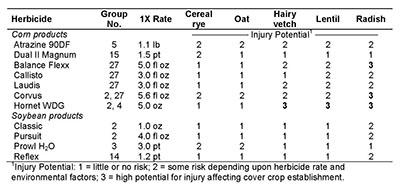Source: Iowa State University Extension and Outreach
The interest in cover crops has increased recently due to the benefits they can provide to the corn-soybean cropping system. The use of residual herbicides has increased at the same time, and the potential impact these herbicides may have on establishing cover crops is an important consideration.
Herbicide labels usually include information regarding restrictions for rotational crops, and in many situations the restrictions were not developed in respect to cover crops. The two primary reasons for the rotational crop restrictions are 1) residues interfering with crop establishment, and 2) residues accumulating in rotational crops that may be fed to animals or humans. Due to the potential for herbicides with no established residue tolerances entering the food chain, it is essential to follow all rotational restrictions on labels when planting cover crops that may be grazed or harvested for forage.
In situations where the cover crop is only used for conservation practices, greater flexibility is provided although the grower assumes the risk if the herbicide should interfere with the establishment of the cover crop. As cover crops are planted more widely, labels likely will change to take them into account. For example, the Harness label now states that only non-food or non-feed winter cover crops may be planted following harvest of food crops treated with Harness.
The potential for herbicides to prevent successful establishment of cover crops is an important consideration. The threat posed by a herbicide is determined by the chemical’s half-life and availability in the soil, sensitivity of the cover crop species, herbicide application rate and date, and environmental conditions throughout the growing season. Late herbicide applications and limited rainfall following application will increase the potential for crop injury. The relatively short time period between cover crop planting dates and the onset of cool fall temperatures increases the risk that herbicides pose to cover crops.
We evaluated the response of five cover crop species to several persistent herbicides commonly used in Iowa corn and soybean production. All experiments were conducted in the greenhouse, thus the studies provide information on the relative tolerance of the five cover crop species to the herbicides rather than an assessment of actual risk under field conditions.
Results of the greenhouse trials are summarized in Table 1. The ratings are based on both greenhouse experiments and experiences with herbicides in the field. Radish was the most sensitive of the cover crops evaluated, with significant injury occurring with all herbicides except Dual II Magnum and Prowl. Cereal rye was the most tolerant of the cover crops. Hornet caused serious injury to plant death on the three broadleaf species, whereas Corvus affected the growth and vigor of all species.

There are many benefits associated with inclusion of cover crops into the corn-soybean cropping systems that dominate the Iowa landscape. Our relatively short growing season limits the time period for growth of cover crops following planting and the onset of dormancy, thus increasing the threat posed by herbicide residues. Cereal rye has a relatively high tolerance to the herbicides commonly used in corn and soybean, and under most situations its establishment should not be affected by herbicides used earlier in the growing season. Other cover crop species are more sensitive to herbicides, and the potential impacts of herbicides on their establishment should be considered. Finally, always follow any rotational restrictions on the herbicide label when cover crops might be harvested for forage or grazed.




Post a comment
Report Abusive Comment